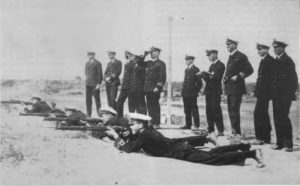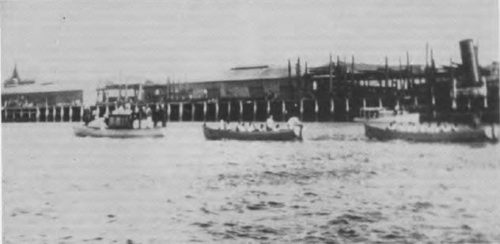- Author
- Jarrett, Hugh
- Subjects
- History - general, Biographies and personal histories
- Tags
-
- RAN Ships
- HMAS Parramatta II
- Publication
- December 1994 edition of the Naval Historical Review (all rights reserved)

the camem is Jack Netherton and, next to him, Sam Benson. Lieutenant Jarrett in charge of the firing point with the DNO, Commander A.J. Loudon-Shand, RAN, standing in rear.
About this time, the effects of the Great Depression were being felt in Australia and the Navy was hit by the `Axe’. A large number of officers and men were retrenched and those that remained took a one-third (approx) cut in their salaries. My father was one of the latter. So we were very fortunate, being housed with a regular income. One result was that I learned to like bread and dripping – and still do!
Industrial troubles came with the Depression, particularly in Port Adelaide, where the wharf labourers rioted and there were mounted police baton charges. The authorities called out the Militia to throw a cordon across Le Fevre Peninsula at Fort Largs, where now stands the Police Training School.
Naval Reservists also were involved in the industrial troubles. Many worked on wharves and spent their daylight hours picketing and battling the police and `scabs’. But on Tuesday nights they put on the King’s uniform and attended their drills. Most of them saw service in the war which was to follow and made splendid sailors, and some, no doubt, gave their lives.
The rioting caused such concern that all the small arms at the Depot had their bolts and locks removed and, along with ammunition, taken under police escort to Adelaide Gaol and locked away in a cell.
My father was a busy man involved in rifle shooting, regattas, military tattoos, parades and ceremonial events besides being responsible for the training aspects of the Depot. The RANR rifle teams became a force to be reckoned with in the weekend competitions and the ‘Rockie’ cutters crews gave the more professional Fleet crews a run for their money whenever the cruisers visited Port Adelaide.
The annual RANR Regatta was a big event which always attracted good crowds. The most popular event was the ExNavalmen’s Race. The old matelots manned the cutters and raced over a short course, having regard for their ages and fitness. On one occasion, the stroke of the winning crew was Bill Perry, well-known as an office-holder in the Ex Navalmen’s Association and a wealthy man who had invested wisely in mining. His main claim to fame was that he first came to Australia in HMS BACCHANTE where he was hammock-hand for the Midshipman who was to become King George V.
He lined up with his cutter’s crew to receive the trophy from the Governor’s Lady who shook his hand and said: “My word Mr Petty – you did very well.” To which he replied:
“Yes your ladyship – and do you know – it’s the first time in years that I’ve ‘ad an hoar in me ‘and!” Her ladyship nearly had hysterics, but not, I imagine, because her name was Hore Ruthven!

Spending our childhood in this milieu had the effect of making us very Navy-oriented, which is not surprising. We spent most of our spare time at the Naval boatshed, and with no doubt, annoying the shipwright, and spending many hours on the river rowing about in a naval dinghy, fishing and absorbing the maritime scene surrounding us. By the time I was thirteen, my brother and I could rig and sail a 27-foot naval whaler.
Every year the wheat fleet of great sailing ships arrived in South Australia and many came to Port Adelaide. Looking across the port one could see a forest of masts and yard-arms with their myriads of shrouds and lines rising above the rooftops.




